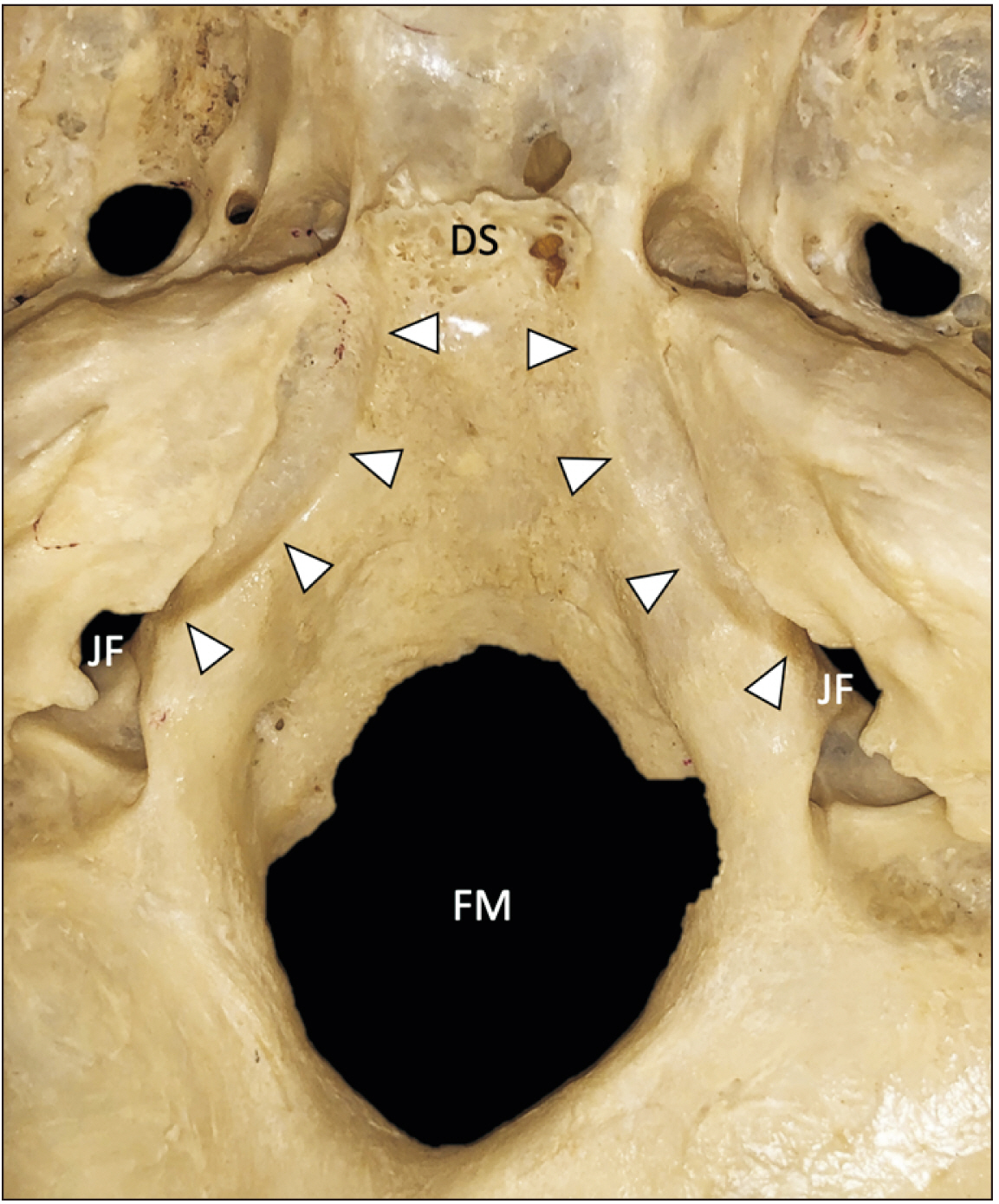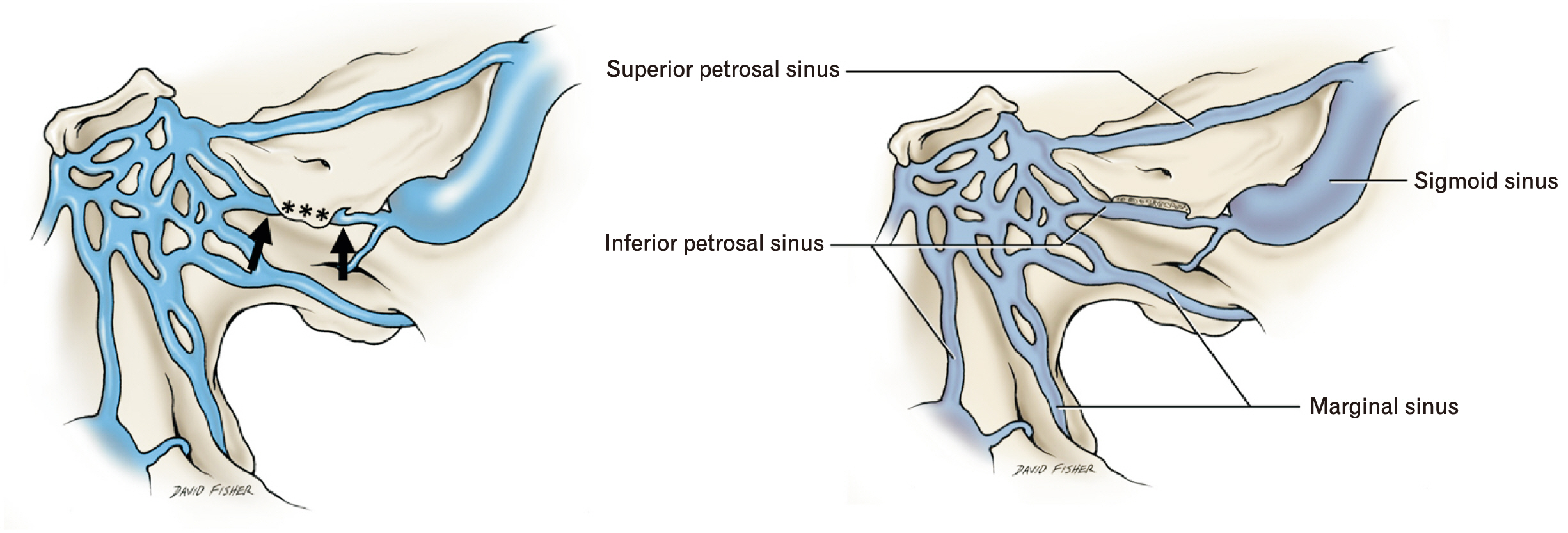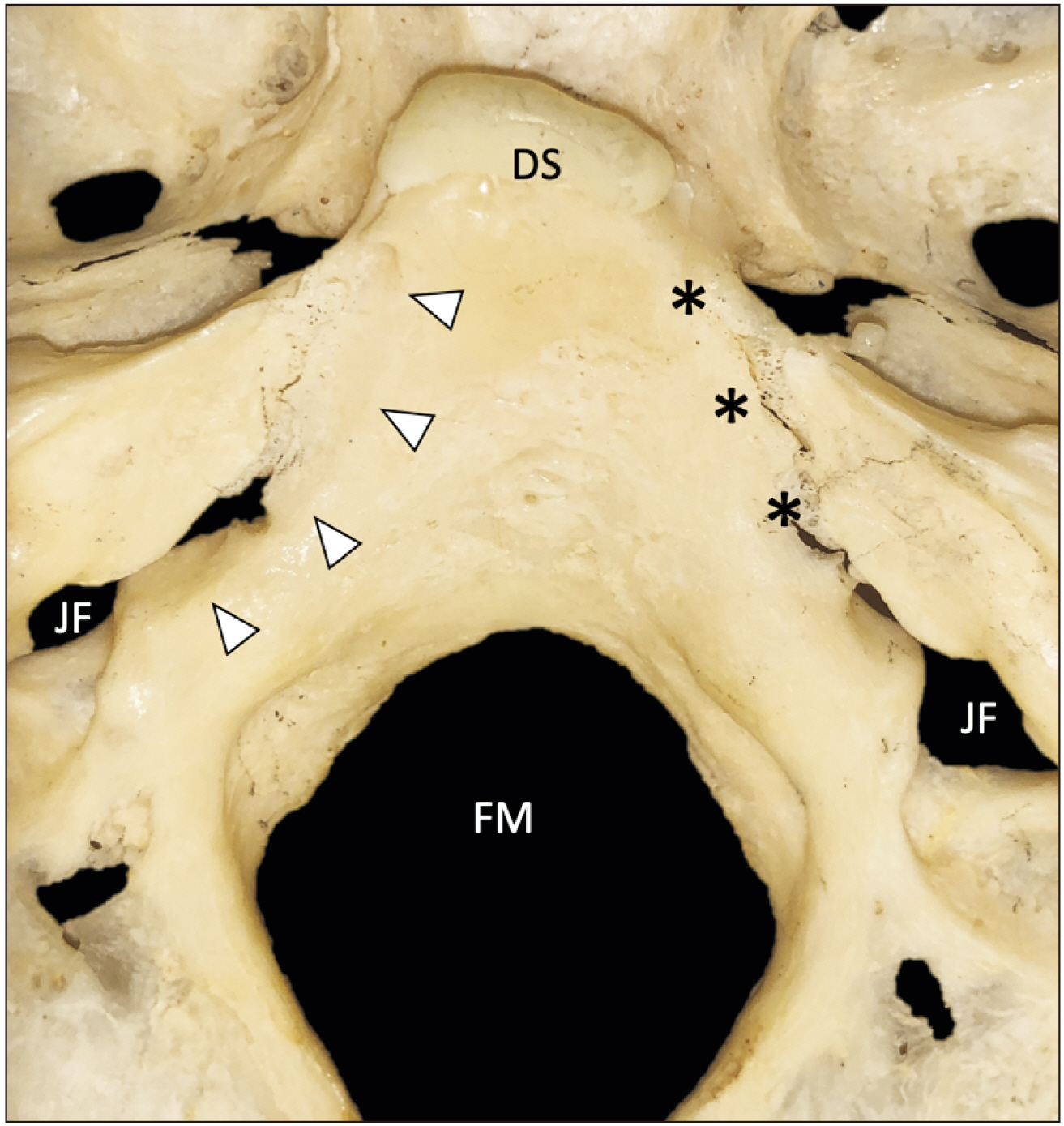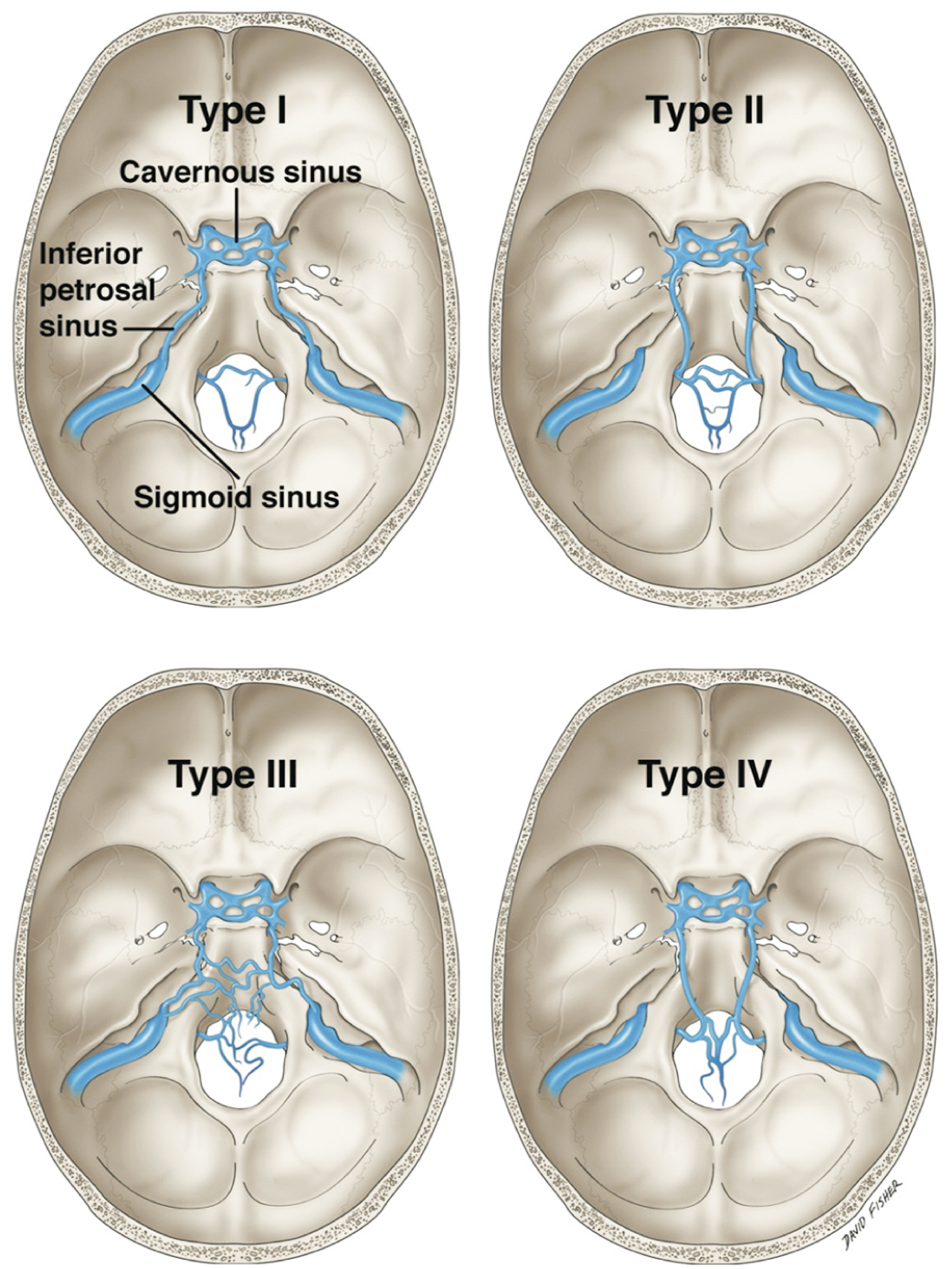Anat Cell Biol.
2022 Jun;55(2):135-141. 10.5115/acb.22.023.
Morphology of the groove of the inferior petrosal sinus: application to better understanding variations and surgery of the skull base
- Affiliations
-
- 1Tulane University School of Medicine, New Orleans, LA, USA
- 2Department of Anatomical Dissection and Donation, Medical University of Lodz, Lodz, Poland
- 3Section of Human Anatomy, Department of Neuroscience, University of Padova, Padova, Italy
- 4Department of Neurosurgery, Tulane Center for Clinical Neurosciences, Tulane University School of Medicine, New Orleans, LA, USA
- 5Department of Neurology, Tulane Center for Clinical Neurosciences, Tulane University School of Medicine, New Orleans, LA, USA
- 6Department of Anatomical Sciences, St. George’s University, St. George’s, Grenada
- 7Department of Structural & Cellular Biology, Tulane University School of Medicine, New Orleans, LA, USA
- 8Department of Surgery, Tulane University School of Medicine, New Orleans, LA, USA
- 9Department of Neurosurgery and Ochsner Neuroscience Institute, Ochsner Health System, New Orleans, LA, USA
- 10University of Queensland, Brisbane, Australia
- KMID: 2531199
- DOI: http://doi.org/10.5115/acb.22.023
Abstract
- Although adequate venous drainage from the cranium is imperative for maintaining normal intracranial pressure, the bony anatomy surrounding the inferior petrosal sinus and the potential for a compressive canal or tunnel has, to our knowledge, not been previously investigated. One hundred adult human skulls (200 sides) were observed and documented for the presence or absence of an inferior petrosal groove or canal. Measurements were made and a classification developed to help better understand their anatomy and discuss it in future reports. We identified an inferior petrosal sinus groove (IPSG) in the majority of specimens. The IPSG began anteriorly where the apex of the petrous part of the temporal bone articulated with the sphenoid part of the clivus, traveled posteriorly, in a slight medial to lateral course, primarily just medial to the petro-occipital fissure, and ended at the anteromedial aspect of the jugular foramen. When the IPSGs were grouped into five types. In type I specimens, no IPSG was identified (10.0%), in type II specimens, a partial IPSG was identified (6.5%), in type III specimens, a complete IPSG (80.0%) was identified, in type IV specimens, a partial IPS tunnel was identified (2.5%), and in type V specimens, a complete tunnel (1.0%) was identified. An improved knowledge of the bony pathways that the intracranial dural venous sinuses take as they exit the cranium is clinically useful. Radiological interpretation of such bony landmarks might improve patient diagnoses and surgically, such anatomy could decrease patient morbidity during approaches to the posterior cranial fossa.
Keyword
Figure
Cited by 1 articles
-
Morphological analysis and morphometry of the occipital condyle and its relationship to the foramen magnum, jugular foramen, and hypoglossal canal: implications for craniovertebral junction surgery
Pakpoom Thintharua, Vilai Chentanez
Anat Cell Biol. 2023;56(1):61-68. doi: 10.5115/acb.22.105.
Reference
-
References
1. Doepp F, Hoffmann O, Lehmann R, Einhäupl KM, Valdueza JM. 1999; The inferior petrosal sinus: assessment by transcranial Doppler ultrasound using the suboccipital approach. J Neuroimaging. 9:193–7. DOI: 10.1111/jon199994193. PMID: 10540597.
Article2. Benndorf G, Campi A. 2002; Aberrant inferior petrosal sinus: unusual transvenous approach to the cavernous sinus. Neuroradiology. 44:158–63. DOI: 10.1007/s002340100659. PMID: 11942369.
Article3. Mortazavi MM, Griessenauer CJ, Krishnamurthy S, Verma K, Loukas M, Tubbs RS. 2014; The inferior petrosal sinus: a comprehensive review with emphasis on clinical implications. Childs Nerv Syst. 30:831–4. DOI: 10.1007/s00381-014-2378-7. PMID: 24526343.
Article4. Mitsuhashi Y, Nishio A, Kawahara S, Ichinose T, Yamauchi S, Naruse H, Matsuoka Y, Ohata K, Hara M. 2007; Morphologic evaluation of the caudal end of the inferior petrosal sinus using 3D rotational venography. AJNR Am J Neuroradiol. 28:1179–84. DOI: 10.3174/ajnr.A0489. PMID: 17569984. PMCID: PMC8134147.
Article5. Paksoy Y, Genç BO, Genç E. 2003; Retrograde flow in the left inferior petrosal sinus and blood steal of the cavernous sinus associated with central vein stenosis: MR angiographic findings. AJNR Am J Neuroradiol. 24:1364–8. PMID: 12917128. PMCID: PMC7973675.6. Jia ZY, Song YS, Sheen JJ, Kim JG, Lee DH, Suh DC. 2018; Cannulation of occluded inferior petrosal sinuses for the transvenous embolization of cavernous sinus dural arteriovenous fistulas: usefulness of a frontier-wire probing technique. AJNR Am J Neuroradiol. 39:2301–6. DOI: 10.3174/ajnr.A5868. PMID: 30385474. PMCID: PMC7655399.
Article7. Deipolyi AR, Hirsch JA, Oklu R. 2012; Bilateral inferior petrosal sinus sampling. J Neurointerv Surg. 4:215–8. DOI: 10.1136/neurintsurg-2011-010033. PMID: 21990499.
Article8. Tomycz ND, Horowitz MB. 2009; Inferior petrosal sinus sampling in the diagnosis of sellar neuropathology. Neurosurg Clin N Am. 20:361–7. DOI: 10.1016/j.nec.2009.01.003. PMID: 19778704.
Article9. Doppman JL, Chang R, Oldfield EH, Chrousos G, Stratakis CA, Nieman LK. 1999; The hypoplastic inferior petrosal sinus: a potential source of false-negative results in petrosal sampling for Cushing's disease. J Clin Endocrinol Metab. 84:533–40. DOI: 10.1210/jcem.84.2.5475. PMID: 10022412.
Article10. Boolell M, Gilford E, Arnott R, McNeill P, Cummins J, Alford F. 1990; An overview of bilateral synchronous inferior petrosal sinus sampling (BSIPSS) in the pre-operative assessment of Cushing's disease. Aust N Z J Med. 20:765–70. DOI: 10.1111/j.1445-5994.1990.tb00420.x. PMID: 1963296.
Article11. Miller DL, Doppman JL, Chang R. 1993; Anatomy of the junction of the inferior petrosal sinus and the internal jugular vein. AJNR Am J Neuroradiol. 14:1075–83. PMID: 8237683. PMCID: PMC8332769.12. Lv X, Wu Z. 2015; Anatomic variations of internal jugular vein, inferior petrosal sinus and its confluence pattern: implications in inferior petrosal sinus catheterization. Interv Neuroradiol. 21:769–73. DOI: 10.1177/1753425915590067. PMID: 26378071. PMCID: PMC4757346.
Article13. Zhang L, Zeng F, Wang J, Chen F. 2019; Finding the inferior petrosal sinus for embolizing cavernous dural arteriovenous fistula using preoperative computed tomography angiography. World Neurosurg. 126:e1069–74. DOI: 10.1016/j.wneu.2019.03.047. PMID: 30878755.
Article14. Benndorf G, Bender A, Lehmann R, Lanksch W. 2000; Transvenous occlusion of dural cavernous sinus fistulas through the thrombosed inferior petrosal sinus: report of four cases and review of the literature. Surg Neurol. 54:42–54. DOI: 10.1016/S0090-3019(00)00260-3. PMID: 11024506.
Article15. Cho YD, Rhim JK, Yoo DH, Kang HS, Kim JE, Cho WS, Han MH. 2016; Transvenous microguidewire looping technique for breach of ipsilateral inferior petrosal sinus occlusions en route to cavernous sinus dural arteriovenous fistulas. Interv Neuroradiol. 22:590–5. DOI: 10.1177/1591019916653251. PMID: 27298011. PMCID: PMC5072206.
Article16. Robert T, Valsecchi D, Sylvestre P, Blanc R, Ciccio G, Smajda S, Redjem H, Piotin M. 2018; May the inferior petrosal sinus recanalization during endovascular treatment for carotid-cavernous fistulas increase the risk of sixth nerve palsy? World Neurosurg. 116:e246–51. DOI: 10.1016/j.wneu.2018.04.182. PMID: 29730099.
Article17. Raghuram K, Durgam A, Sartin S. 2018; Assessment of the inferior petrosal sinus on T1-weighted contrast-enhanced magnetic resonance imaging. J Clin Imaging Sci. 8:22. DOI: 10.4103/jcis.JCIS_1_18. PMID: 30034926. PMCID: PMC6029007.
Article18. Gebarski SS, Gebarski KS. 1995; Inferior petrosal sinus: imaging-anatomic correlation. Radiology. 194:239–47. DOI: 10.1148/radiology.194.1.7997561. PMID: 7997561.
Article19. Lo WW, Solti-Bohman LG. 1984; High-resolution CT of the jugular foramen: anatomy and vascular variants and anomalies. Radiology. 150:743–7. DOI: 10.1148/radiology.150.3.6320256. PMID: 6320256.
Article20. Shiu PC, Hanafee WN, Wilson GH, Rand RW. 1968; Cavernous sinus venography. Am J Roentgenol Radium Ther Nucl Med. 104:57–62. DOI: 10.2214/ajr.104.1.57. PMID: 5672775.
Article21. Day JD. 2004; Intradural jugular tubercle reduction to enhance exposure via the transcondylar approach: technical note. Neurosurgery. 55:247–50. discussion 251DOI: 10.1227/01.NEU.0000126884.63619.25. PMID: 15214997.
Article22. Iwanaga J, Singh V, Ohtsuka A, Hwang Y, Kim HJ, Moryś J, Ravi KS, Ribatti D, Trainor PA, Sañudo JR, Apaydin N, Şengül G, Albertine KH, Walocha JA, Loukas M, Duparc F, Paulsen F, Del Sol M, Adds P, Hegazy A, Tubbs RS. 2021; Acknowledging the use of human cadaveric tissues in research papers: recommendations from anatomical journal editors. Clin Anat. 34:2–4. DOI: 10.1002/ca.23671. PMID: 32808702.
Article23. Iwanaga J, Singh V, Takeda S, Ogeng'o J, Kim HJ, Moryś J, Ravi KS, Ribatti D, Trainor PA, Sañudo JR, Apaydin N, Sharma A, Smith HF, Walocha JA, Hegazy AMS, Duparc F, Paulsen F, Del Sol M, Adds P, Louryan S, Fazan VPS, Boddeti RK, Tubbs RS. 2022; Feb. 26. Standardized statement for the ethical use of human cadaveric tissues in anatomy research papers: recommendations from Anatomical Journal Editors-in-Chief. Clin Anat. [Epub]. https://doi.org/10.1002/ca.23849. DOI: 10.1002/ca.23849. PMID: 35218594.
Article
- Full Text Links
- Actions
-
Cited
- CITED
-
- Close
- Share
- Similar articles
-
- Cadaveric findings of a duplicated superior petrosal sinus
- Iatrogenic Skull Base Defect Accompanied by Brain Injury After Endoscopic Sinus Surgery: A Report of Two Cases
- A Case of Massive Skull Base Erosion by Fungus Ball in the Sphenoid Sinus
- A Clinical study on the diagnesis and Treatment of Cushing's Disease - The significance of bilateral inferior petrosal sinus sampling -
- A Case of Endoscopic Reconstruction of Skull Base Defect Combined with Meningoencephalocele in the Sphenoid Sinus








